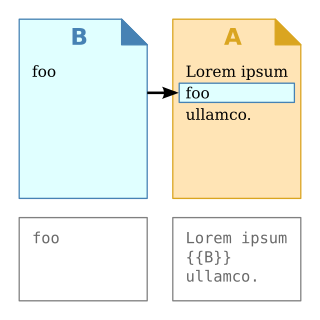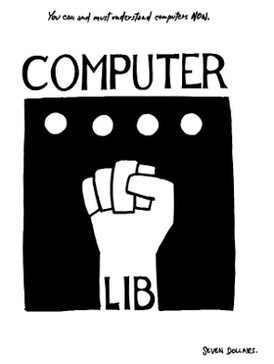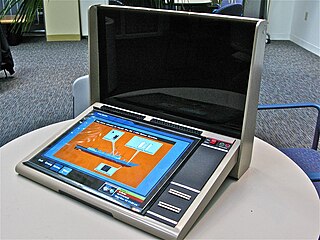Related Research Articles

Hypertext is text displayed on a computer display or other electronic devices with references (hyperlinks) to other text that the reader can immediately access. Hypertext documents are interconnected by hyperlinks, which are typically activated by a mouse click, keypress set, or screen touch. Apart from text, the term "hypertext" is also sometimes used to describe tables, images, and other presentational content formats with integrated hyperlinks. Hypertext is one of the key underlying concepts of the World Wide Web, where Web pages are often written in the Hypertext Markup Language (HTML). As implemented on the Web, hypertext enables the easy-to-use publication of information over the Internet.

In computer science, transclusion is the inclusion of part or all of an electronic document into one or more other documents by reference via hypertext. Transclusion is usually performed when the referencing document is displayed, and is normally automatic and transparent to the end user. The result of transclusion is a single integrated document made of parts assembled dynamically from separate sources, possibly stored on different computers in disparate places.

Theodor Holm Nelson is an American pioneer of information technology, philosopher, and sociologist. He coined the terms hypertext and hypermedia in 1963 and published them in 1965. According to a 1997 Forbes profile, Nelson "sees himself as a literary romantic, like a Cyrano de Bergerac, or 'the Orson Welles of software'."

In computing, a hyperlink, or simply a link, is a digital reference to data that the user can follow or be guided to by clicking or tapping. A hyperlink points to a whole document or to a specific element within a document. Hypertext is text with hyperlinks. The text that is linked from is known as anchor text. A software system that is used for viewing and creating hypertext is a hypertext system, and to create a hyperlink is to hyperlink. A user following hyperlinks is said to navigate or browse the hypertext.
Project Xanadu was the first hypertext project, founded in 1960 by Ted Nelson. Administrators of Project Xanadu have declared it superior to the World Wide Web, with the mission statement: "Today's popular software simulates paper. The World Wide Web trivialises our original hypertext model with one-way ever-breaking links and no management of version or contents."
This article presents a timeline of hypertext technology, including "hypermedia" and related human–computer interaction projects and developments from 1945 on. The term hypertext is credited to the author and philosopher Ted Nelson.
Hypermedia, an extension of the term hypertext, is a nonlinear medium of information that includes graphics, audio, video, plain text and hyperlinks. This designation contrasts with the broader term multimedia, which may include non-interactive linear presentations as well as hypermedia. It is also related to the field of electronic literature. The term was first used in a 1965 article written by Ted Nelson.

In interface design, a tab is a graphical user interface object that allows multiple documents or panels to be contained within a single window, using tabs as a navigational widget for switching between sets of documents. It is an interface style most commonly associated with web browsers, web applications, text editors, and preference panes, with window managers and tiling window managers.

afternoon, a story, spelled with a lowercase 'a', is a work of electronic literature written in 1987 by American author Michael Joyce. It was published by Eastgate Systems in 1990 and is known as one of the first works of hypertext fiction.
George Paul Landow was Professor of English and Art History Emeritus at Brown University. He was a leading authority on Victorian literature, art, and culture, as well as a pioneer in criticism and theory of Electronic literature, hypertext and hypermedia. He also pioneered the use of hypertext and the web in higher education.
The Victorian Web is a hypertext project derived from hypermedia environments, Intermedia and Storyspace, that anticipated the World Wide Web. Initially created between 1988 and 1990 with 1,500 documents, it has grown to over 128,500 items in July 2023. In contrast to archives and web-based libraries, the Victorian Web presents its images and documents, including entire books, as nodes in a network of complex connections. It emphasizes links rather than the searches.
Intermedia was the third notable hypertext project to emerge from Brown University, after HES (1967) and FRESS (1969). Intermedia was started in 1985 by Norman Meyrowitz, who had been associated with earlier hypertext research at Brown. The Intermedia project coincided with the establishment of the Institute for Research in Information and Scholarship (IRIS). Some of the materials that came from Intermedia, authored by Meyrowitz, Nancy Garrett, and Karen Catlin were used in the development of HTML.

Computer Lib/Dream Machines is a 1974 book by Ted Nelson, printed as a two-front-cover paperback to indicate its "intertwingled" nature. Originally self-published by Nelson, it was republished with a foreword by Stewart Brand in 1987 by Microsoft Press.

Jane Yellowlees Douglas is a pioneer author and scholar of hypertext fiction. She began writing about hypermedia in the late 1980s, very early in the development of the medium. Her 1993 fiction I Have Said Nothing, was one of the first published works of hypertext fiction.
Hyperland is a 50-minute-long documentary film about hypertext and surrounding technologies. It was written by Douglas Adams and produced and directed by Max Whitby for BBC Two in 1990. It stars Douglas Adams as a computer user and Tom Baker, with whom Adams had already worked on Doctor Who, as a personification of a software agent.
Hypervideo, or hyperlinked video, is a displayed video stream that contains embedded, interactive anchors, allowing navigation between video and other hypermedia elements. Hypervideo is similar to hypertext, which allows a reader to click on a word in one document and retrieve information from another document, or another place in the same document. Hypervideo combines video with a non-linear information structure, allowing a user to make choices based on the content of the video and the user's interests.

The Electronic Document System (EDS) was an early hypertext system – also known as the Interactive Graphical Documents (IGD) hypermedia system – focused on creation of interactive documents such as equipment repair manuals or computer-aided instruction texts with embedded links and graphics. EDS was a 1978–1981 research project at Brown University by Steven Feiner, Sandor Nagy and Andries van Dam.
User modeling is the subdivision of human–computer interaction which describes the process of building up and modifying a conceptual understanding of the user. The main goal of user modeling is customization and adaptation of systems to the user's specific needs. The system needs to "say the 'right' thing at the 'right' time in the 'right' way". To do so it needs an internal representation of the user. Another common purpose is modeling specific kinds of users, including modeling of their skills and declarative knowledge, for use in automatic software-tests. User-models can thus serve as a cheaper alternative to user testing but should not replace user testing.

Dame Wendy Hall is a British computer scientist. She is Regius Professor of Computer Science at the University of Southampton.

Hypertext is text displayed on a computer or other electronic device with references (hyperlinks) to other text that the reader can immediately access, usually by a mouse click or keypress sequence. Early conceptions of hypertext defined it as text that could be connected by a linking system to a range of other documents that were stored outside that text. In 1934 Belgian bibliographer, Paul Otlet, developed a blueprint for links that telescoped out from hypertext electrically to allow readers to access documents, books, photographs, and so on, stored anywhere in the world.
References
- ↑ Jakob Nielsen (1 January 1995). "Architectural Component of Hypertext Systems" . Retrieved 21 January 2013.
- ↑ Fountain, Andrew; Hall, Wendy; Heath, Ian; Davis, Hugh (1990). MICROCOSM: an open model for hypermedia with dynamic linking. Cambridge University Press. pp. 298–311.
- ↑ Gillies, James; Cailliau, Robert. How the Web was Born. Oxford University Press. p. 129. ISBN 978-0-19-286207-5.